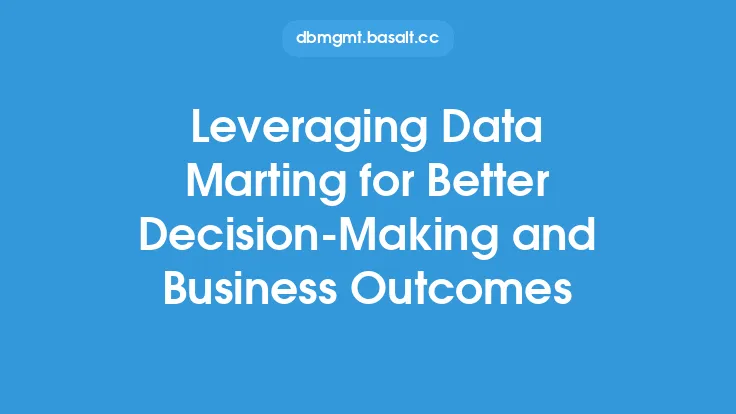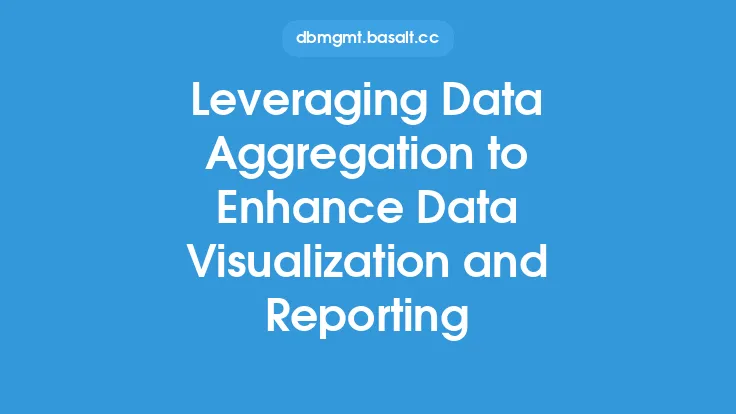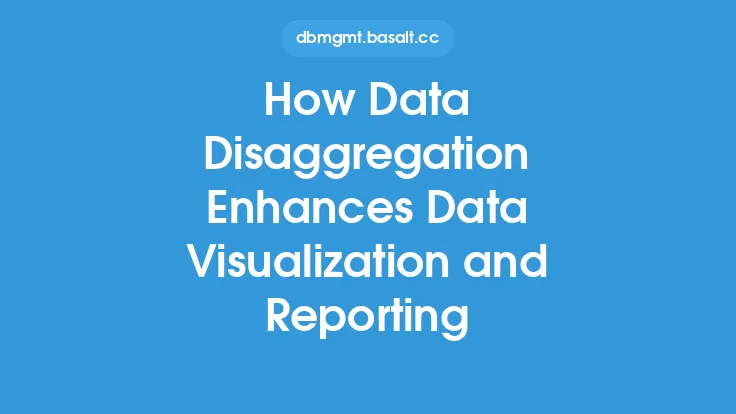Data marting is a crucial aspect of data denormalization, which involves the process of organizing and structuring data in a way that facilitates efficient querying and analysis. In the context of data visualization and reporting, data marting techniques play a vital role in enhancing the overall quality and effectiveness of these processes. By applying data marting techniques, organizations can create a robust and scalable data infrastructure that supports advanced data analysis, reporting, and visualization capabilities.
Introduction to Data Marting Techniques
Data marting techniques involve the creation of a specialized database that contains a subset of data from a larger database or data warehouse. This subset of data is specifically designed to support a particular business function or department, such as sales, marketing, or finance. The data mart is typically optimized for querying and analysis, with a focus on providing fast and efficient access to the data. Data marting techniques can be applied to various types of data, including relational, multidimensional, and big data.
Benefits of Data Marting for Data Visualization and Reporting
The application of data marting techniques can bring numerous benefits to data visualization and reporting. Some of the key advantages include:
- Improved query performance: Data marting techniques can significantly improve query performance by reducing the amount of data that needs to be processed and analyzed.
- Enhanced data quality: Data marting involves the creation of a specialized database that is optimized for querying and analysis, which can help to improve data quality by reducing errors and inconsistencies.
- Increased scalability: Data marting techniques can support large volumes of data and user traffic, making them ideal for big data and business intelligence applications.
- Better data governance: Data marting involves the creation of a centralized repository of data, which can help to improve data governance by providing a single source of truth for data-related activities.
Data Marting Techniques for Enhanced Data Visualization
Data marting techniques can be applied to enhance data visualization in several ways. Some of the key techniques include:
- Data aggregation: Data aggregation involves the process of combining data from multiple sources into a single, unified view. This can help to improve data visualization by providing a more comprehensive and detailed view of the data.
- Data transformation: Data transformation involves the process of converting data from one format to another. This can help to improve data visualization by providing data in a format that is more suitable for analysis and reporting.
- Data indexing: Data indexing involves the process of creating indexes on data to improve query performance. This can help to improve data visualization by providing faster and more efficient access to the data.
- Data partitioning: Data partitioning involves the process of dividing data into smaller, more manageable chunks. This can help to improve data visualization by providing a more focused and detailed view of the data.
Data Marting Techniques for Enhanced Reporting
Data marting techniques can also be applied to enhance reporting in several ways. Some of the key techniques include:
- Data summarization: Data summarization involves the process of summarizing data into a more concise and meaningful format. This can help to improve reporting by providing a more detailed and comprehensive view of the data.
- Data drill-down: Data drill-down involves the process of providing detailed data to support high-level summaries. This can help to improve reporting by providing a more detailed and nuanced view of the data.
- Data filtering: Data filtering involves the process of selecting specific data to include in reports. This can help to improve reporting by providing a more focused and relevant view of the data.
- Data sorting: Data sorting involves the process of arranging data in a specific order. This can help to improve reporting by providing a more organized and meaningful view of the data.
Technical Considerations for Data Marting
When implementing data marting techniques, there are several technical considerations that need to be taken into account. Some of the key considerations include:
- Data storage: Data marting requires a significant amount of data storage, which can be a challenge for organizations with limited resources.
- Data processing: Data marting requires significant data processing power, which can be a challenge for organizations with limited computational resources.
- Data security: Data marting involves the creation of a centralized repository of data, which can be a security risk if not properly protected.
- Data governance: Data marting involves the creation of a centralized repository of data, which can be a challenge for organizations with limited data governance capabilities.
Best Practices for Implementing Data Marting Techniques
When implementing data marting techniques, there are several best practices that need to be followed. Some of the key best practices include:
- Define clear business requirements: Data marting techniques should be designed to meet specific business requirements and use cases.
- Choose the right data model: The data model should be chosen based on the specific business requirements and use cases.
- Optimize data storage: Data storage should be optimized to support fast and efficient querying and analysis.
- Implement data governance: Data governance should be implemented to ensure that data is accurate, complete, and secure.
- Monitor and maintain: The data mart should be regularly monitored and maintained to ensure that it continues to meet business requirements and use cases.
Conclusion
Data marting techniques are a crucial aspect of data denormalization, and play a vital role in enhancing data visualization and reporting. By applying data marting techniques, organizations can create a robust and scalable data infrastructure that supports advanced data analysis, reporting, and visualization capabilities. When implementing data marting techniques, it is essential to consider technical factors such as data storage, data processing, data security, and data governance, and to follow best practices such as defining clear business requirements, choosing the right data model, optimizing data storage, implementing data governance, and monitoring and maintaining the data mart. By doing so, organizations can unlock the full potential of their data and make better-informed decisions to drive business success.





